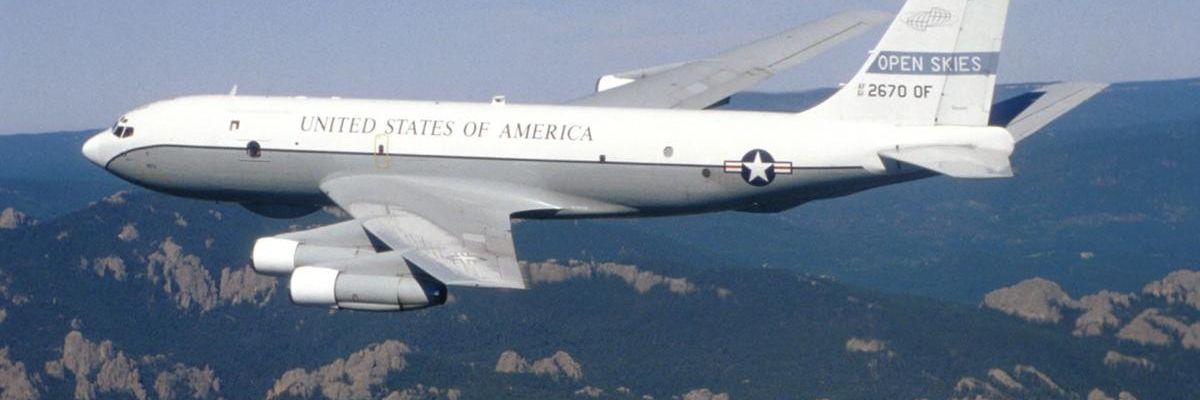In a now painfully familiar exercise, the Trump administration said this past week that it would leave yet another international agreement. This time it is the Open Skies Treaty, which the United States, Russia, and 32 other Euro-Atlantic countries — most of whom are U.S. allies — have been quietly using for years to help keep the tensions troubling the region focused on facts instead of false assumptions and blind fears.
Open Skies Treaty parties let each other fly short-notice observation flights over their territories. Everything is done through prior agreement and treaty rules. Countries agree on image resolution, sensor equipment, annual flight plans, flight routes, and even the observation planes themselves. Images collected are available to all parties. The intensive cooperation and coordination demanded by the treaty produces knock-on benefits of confidence-building.
The treaty stemmed from a vision set out by President Dwight Eisenhower. President George H.W. Bush re-imagined and then negotiated it. The Senate approved it without opposition and then later President George W. Bush shepherded it into force.
The Trump administration, and treaty critics who have long angled for withdrawal, want Americans to think this move was oh-so-regrettably forced upon them. Nothing could be further from the truth. For them, the Open Skies Treaty is a binding arms control deal — and any deal that binds the United States with an adversary is inherently bad. They just wanted out.
To be sure, some of Russia’s treaty implementation raises real concerns. But its actions have not defeated the object and purpose of the treaty. The obstacles that remain did not prevent the United States and its allies from gaining valuable insights into military force movements across the Euro-Atlantic. These countries found the unassailable visual data on Russian military activities that the treaty produced in and around Ukraine particularly useful. All in all, the United States has conducted significantly more flights over Russia and its treaty partner Belarus since 2002 (181) than the other way around (77). (Check out this invaluable scorecard of treaty flights to learn more.) That is why so many U.S. allies are dumbstruck to see the United States give up on the deal’s dispute resolution mechanisms — which had resolved past disagreements over restrictions on some flight altitudes and VIP movements.
Now many of America’s European allies are not mincing words. They like Open Skies. They believe it enhances their security. For countries without access to their own satellites, the treaty gives them their own sense for what Russia is doing with its military. They do not want to beg for American imagery or buy it from Google. For months they have been pressing U.S. officials to stay in the treaty.
After the Trump move, the foreign ministries of Belgium, Czech Republic, Finland, France, Germany, Italy, Luxemburg, Netherlands, Spain, and Sweden stood their ground. They noted their regret but affirmed that they will remain because they see “clear added value” from the treaty for their own security. Again, they must endure the new pattern: Moscow plays fast and loose with the rules, and Washington storms out. Europe is stuck in the middle with no one to trust.
Russia — never one to miss the chance to shoot diplomatic fish that America obligingly dumps into barrels — said that its commitment to Open Skies will continue. This will soon tee up the obvious follow-on dilemma. Given the administration’s vague claims that Russia was somehow misusing treaty-acquired imagery, will Washington now pressure allies when Russia predictably runs treaty flights over hosted U.S. military assets in Europe?
Secretary of State Pompeo did not even try to paper over allies’ displeasure. In his own statement, he acknowledged, “We understand that many of our Allies and partners in Europe still find value in the Treaty.” Then he dug the knife in deep: “If not for the value they place on the [Open Skies Treaty], we would likely have exited long ago.” One doubts the sentiment offered much comfort.
America’s allies surely see the scrapping of Open Skies in the larger pattern of ditching the Iran deal, ending the INF Treaty, publicly bashing fellow allied leaders, questioning why America should fight for a Montenegrin treaty partner’s freedom, shaking down its South Korea ally for defending a country whose freedom America claims is a key interest, pitting one NATO partner against another when the latter dares to democratically discuss how it will contribute to the alliance’s defense, or, most recently, reportedly considering whether to break the near-universal moratorium on explosive nuclear testing in a bid at bullying China to the arms control table.
Allies are not missing the foreign policy forest for this latest felled treaty. They see an America that values sticks over carrots and bravado over brains. Like the cos-playtriots terrorizing state houses around the country, the Trump administration and its fellow travelers might think that menacing appearances and angry rhetoric are all they need to produce results. America’s allies see through this coward’s move. They must now be questioning whether an America that time and again refuses to remain bound by arms control deals can be trusted to remain bound by its alliances.
For more than half a century, American presidents understood that the collective strength of its alliances gave this nation much more influence than its collection of armaments. Those leaders did not reject solutions short of total victory just because they failed to cure every ill. Like the GI’s who secured Europe in generations past, when they hit obstacles and setbacks they kept tinkering, improvising, and searching for better solutions. Indeed, it was the U.S. reliance on tenacity, openness, and ingenuity that kept our allies by our side.
The Trump administration and its ilk has no such patience. They see obstacles and they just quit.
The Open Skies Treaty has served America’s interests by helping stave off a return to Cold War levels of fear-driven militarization and the risk of accident-sparked war. But it also showed that the United States was a fully-engaged transatlantic partner willing to listen and back its allies and their concerns and priorities. Unless President Trump reverses his decision before November 22, the United States will lose security for itself, but also credibility with its friends.
As bad as it is, though, this moment could yet prove to be an opportunity. When considering this country’s future, foreign policy leaders must confront more directly the misguided ideology of “America First.” It is a vision that has always failed to deliver, leaving America standing alone, not first. Lawmakers, policymakers, and the public should re-embrace diplomacy and international cooperation as central tools of American leadership, including by using arms control solutions to regain the security lost from all these deals ditched and agreements abandoned.
In the May 1989 speech when George H.W. Bush first proposed a multilateral Open Skies Treaty, he finished by reflecting on the tragic earthquake that had recently hit the then-Soviet republic of Armenia. “It's a sad truth,” Bush said, “that nothing forces us to recognize our common humanity more swiftly than a natural disaster.” As the United States moves to get beyond this global pandemic, it must heed those words and focus on a foreign policy that embraces the spirit of openness, cooperation, and pragmatism on which the Open Skies Treaty was built.
























